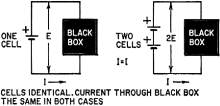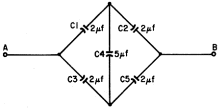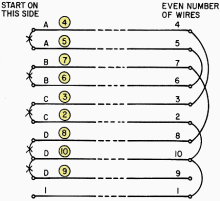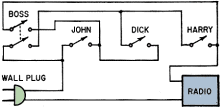|
September 1961 Radio-Electronics
 [Table of Contents] [Table of Contents]
Wax nostalgic about and learn from the history of early electronics.
See articles from Radio-Electronics,
published 1930-1988. All copyrights hereby acknowledged.
|
These "What's Your
EQ?" (electronics quotient) challenges that appeared in
Radio-Electronics magazine are sort of the electronics enthusiast
version of The Old Farmer's Almanac "Old and New
Mathematical Puzzles." Whereas the OFA puzzles could be on any subject -
sometimes including electricity - the RE puzzles are typically based on circuit
analysis and troubleshooting issues. Two of this month's problems are new
versions of old themes. Any time you see a schematic with series and parallel
combinations of components (usually of the same kind), the first thing to do is
attempt to redraw it in a more familiar configuration. The Black Box problems
often have more than one solution; in this instance, at least three "correct"
answers were submitted. The "Over the River" puzzle is reminiscent of an OFA
type puzzle. Have fun.
What's Your EQ?
 Here we go again. Sharpen up your pencils, put
on that thinking cap and settle down to some interesting puzzles. Here we go again. Sharpen up your pencils, put
on that thinking cap and settle down to some interesting puzzles.
If you've got one of your own that will stump our readers, especially if it's
on an engineering level, send it to us. We pay $10 and up for each one accepted.
Write to EQ editor, Radio-Electronics, 154 W. 14 St., New York 11, N. Y. Answers
to July puzzles are on page 89. Answers to this month's puzzles appear next month.
 Series-Parallel Capacitors Series-Parallel Capacitors
Five paper capacitors are connected as shown. The capacitances are given in microfarads.
Now, what is the capacitance between points A and B?
- T. A. Varhelyi
Over the River
Here is a puzzle that should increase aspirin sales:
You have a cable containing 100 wires running under
a river. None of the wires are color-coded. The problem is to identify (using numbered
labels or cable markers) the corresponding wires on both sides of the river. Only
one round trip across the river is permitted and the only piece of equipment that
may be used is a continuity checker (not an ohmmeter).
- Ronald J. Draus
 Black Box No. 3 Black Box No. 3
In the figure, note that at the left, one cell identical to the two cells at
the right is used to power the black box. Further, note that the current drain of
the black box in both cases is the same.
Question: What's in the black box?
- George R. Wisner
Automated Voting
 To solve the usual office problem of whether
to have music or not, one boss installed a double-pole switch on his own desk and
single-pole switches on the desks of each of his three men, John, Dick and Harry,
as shown in the figure. When anyone wants music, he votes for it by closing the
switch at his desk. Closing the boss' switch counts as two votes, while closing
any of the other three switches counts as one vote. When there are three or more
votes for music, the radio comes on. To solve the usual office problem of whether
to have music or not, one boss installed a double-pole switch on his own desk and
single-pole switches on the desks of each of his three men, John, Dick and Harry,
as shown in the figure. When anyone wants music, he votes for it by closing the
switch at his desk. Closing the boss' switch counts as two votes, while closing
any of the other three switches counts as one vote. When there are three or more
votes for music, the radio comes on.
Wire up the circuit. No additional parts are needed,
and the switches need not be altered. Before deciding you have done the job right,
check to make sure the radio will come on for any combination of three or more votes,
and never for any combination of less than three votes.
- Darrell L. Geiger
----- Solutions Below -----
Quizzes from vintage electronics magazines such as Popular
Electronics, Electronics-World, QST,
Radio-Electronics, and Radio News
were published over the years - some really simple and others not so simple. Robert P. Balin
created most of the quizzes for Popular Electronics. This is a listing
of all I have posted thus far.
- RF Cafe Quiz #71:
Tech Headlines for Week of 3/13/2023
- RF Cafe Quiz #70:
Analog &
RF Filter Basics
- RF Cafe Quiz #69:
RF
Electronics Basics
- RF Cafe Quiz #68:
RF & Analog Company Mergers & Acquisitions in 2017
- RF Cafe Quiz #67:
RF & Microwave Company Name Change History
- RF Cafe Quiz #66:
Spectrum and Network Measurements
- RF Cafe Quiz #65:
Troubleshooting & Repairing Commercial Electrical Equipment
- RF Cafe Quiz #64:
Space-Time Adaptive Processing for Radar
- RF Cafe Quiz #63:
Envelope Tracking Power Amplifiers
- RF Cafe Quiz #62:
Stimson's Introduction to Airborne Radar
- RF Cafe Quiz #61:
Practical Microwave Circuits
- RF Cafe Quiz #60:
Ten Essential Skills for Electrical Engineers
- RF Cafe Quiz #59:
Microwave Circulator Design
- RF Cafe Quiz #58:
Microwave and Millimeter-Wave Electronic Packaging
- RF Cafe Quiz #57:
Frequency-Agile Antennas for Wireless Communications
- RF Cafe Quiz #56:
Tube Testers
and Electron Tube Equipment
- RF Cafe Quiz #55:
Conquer
Radio Frequency
- RF Cafe Quiz #54:
Microwave Mixer Technology and Applications
- RF Cafe Quiz #53:
Chipless RFID Reader Architecture
- RF Cafe Quiz #52:
RF and Microwave Power Amplifiers
- RF Cafe Quiz #51:
Antennas and Site Engineering for Mobile Radio Networks
- RF Cafe Quiz #50:
Microstrip Lines and Slotlines
- RF Cafe Quiz #49:
High-Frequency Integrated Circuits
- RF Cafe Quiz #48:
Introduction to Infrared and Electro-Optical Systems
- RF Cafe Quiz #47:
LCP for Microwave Packages and Modules
- RF Cafe Quiz #46:
RF, Microwave, and Millimeter-Wave Components
- RF Cafe Quiz #45:
Dielectric and Thermal Properties of Materials at Microwave Frequencies
- RF Cafe Quiz #44:
Monopulse Principles and Techniques
- RF Cafe Quiz #43:
Plasma Antennas
- RF Cafe Quiz #42: The Micro-Doppler
Effect in Radar
- RF Cafe Quiz #41: Introduction
to RF Design Using EM Simulators
- RF Cafe Quiz #40: Introduction
to Antenna Analysis Using EM Simulation
- RF Cafe Quiz #39: Emerging
Wireless Technologies and the Future Mobile Internet
- RF Cafe Quiz #38: Klystrons,
Traveling Wave Tubes, Magnetrons, Crossed-Field Amplifiers, and Gyrotrons
- RF Cafe Quiz #37: Component
Reliability for Electronic Systems
- RF Cafe Quiz #36: Advanced
RF MEMS
- RF Cafe Quiz #35: Frequency
Synthesizers: Concept to Product
- RF Cafe Quiz #34: Multi-Gigabit
Microwave and Millimeter-Wave Wireless Communications
- RF Cafe Quiz #33: Battlespace
Technologies: Network-Enabled Information Dominance
- RF Cafe Quiz #32: Modern Communications
Receiver Design and Technology
- RF Cafe Quiz #31: Quantum
Mechanics of Nanostructures
- RF Cafe Quiz #30: OFDMA System
Analysis and Design
- RF Cafe Quiz #29: Cognitive
Radar
- RF Cafe Quiz #28: Human-Centered
Information Fusion
- RF Cafe Quiz #27: Remarkable
Engineers
- RF Cafe Quiz #26: Substrate
Noise Coupling in Analog/RF Circuits
- RF Cafe Quiz #25: Component
Reliability for Electronic Systems
- RF Cafe Quiz #24: Ultra Low
Power Bioelectronics
- RF Cafe Quiz #23: Digital
Communications Basics
- RF Cafe Quiz #22: Remember
the Basics?
- RF Cafe Quiz #21: Wireless
Standards Knowledge
- RF Cafe Quiz #20: Famous First
Names
- RF Cafe Quiz #19: Basic Circuit
Theory
- RF Cafe Quiz #18: Archaic
Scientific Words & Definitions
- RF Cafe Quiz #17: Inventors &
Their Inventions
- RF Cafe Quiz #16: Antennas
- RF Cafe Quiz #15: Numerical
Constants
- RF Cafe Quiz #14: Oscillators
- RF Cafe Quiz #13: General
Knowledge
- RF Cafe Quiz #12: Electronics
Corporations Headquarters
- RF Cafe Quiz #11: Famous Inventors &
Scientists
- RF Cafe Quiz #10: A Sampling
of RF & Wireless Topics
- RF Cafe Quiz #9: A Smorgasbord
of RF Topics
- RF Cafe Quiz #8: Hallmark Decades
in Electronics
- RF Cafe Quiz #7: Radar Fundamentals
- RF Cafe Quiz #6: Wireless Communications
Fundamentals
- RF Cafe Quiz #5: Company Logo
Recognition
- RF Cafe Quiz #4: General RF
Topics
- RF Cafe Quiz #3: General RF/Microwave
Topics
- RF Cafe Quiz #2: General RF
Topics
- RF Cafe Quiz #1: General RF
Knowledge
- Vacuum Tube Quiz,
February 1961 Popular Electronics
- Kool-Keeping Kwiz, June
1970 Popular Electronics
- Find the Brightest
Bulb Quiz, April 1960 Popular Electronics
-
Where Do the Scientists Belong? - Feb 19, 1949 Saturday Evening Post
|
-
What's
Your EQ? - February 1962 Radio-Electronics
-
What's
Your EQ? - March 1962 Radio-Electronics
-
What's
Your EQ? - July 1961 Radio-Electronics
-
What's
Your EQ? - August 1961 Radio-Electronics
-
Can You
Name These Strange Electronic Effects? - August 1962 Radio-Electronics
-
What's
Your EQ? - September 1961 Radio-Electronics
-
What's
Your EQ? - September 1962 Radio-Electronics
-
What's Your EQ? - October 1961 Radio-Electronics
-
What's Your EQ? - November 1961 Radio-Electronics
-
What's Your EQ? - March 1964 Radio-Electronics
-
What's Your EQ? - April 1962 Radio-Electronics
-
What's Your EQ? - May 1962 Radio-Electronics
-
What's Your EQ? - June 1962 Radio-Electronics
-
What's Your EQ? - April 1967 Radio-Electronics
-
What's Your EQ? - March 1967 Radio-Electronics
-
What's Your EQ? - December 1964 Radio-Electronics
-
What's Your EQ? - January 1967 Radio-Electronics
-
Wanted: 50,000 Engineers - January 1953 Popular Mechanics
-
What's Your EQ? - August 1964 Radio-Electronics
- Voltage Quiz
- December 1961 Popular Electronics
-
What is It? - June 1941 Popular Science
- What Do You Know
About Resistors? - April 1974 Popular Electronics
-
What's Your EQ? - September 1963 Radio-Electronics
- Potentiometer Quiz - September
1962 Popular Electronics
-
Mathematical Bafflers - March 1965 Mechanix Illustrated
- Op Amp Quiz -
October 1968 Popular Electronics
- Electronic "A"
Quiz - April 1968 Popular Electronics
-
What's Your EQ? - May 1961 Radio-Electronics
-
Popular Science Question Bee - February 1939 Popular Science
-
What is It? - A Question Bee in Photographs - June 1941 Popular Science
-
What's Your EQ? - June 1961 Radio-Electronics
-
What's Your EQ? - June 1964 Radio-Electronics
-
What's Your EQ? - May 1964 Radio-Electronics
-
What's Your EQ? - August 1963 Radio-Electronics
-
What's Your EQ? - May 1963 Radio-Electronics
- Bridge
Function Quiz - September 1969 Radio-Electronics
-
What's Your EQ? - March 1963 Radio-Electronics
-
What's Your EQ? - February 1967 Radio-Electronics
-
Circuit Quiz - June 1966 Radio-Electronics
-
What's Your EQ? - June 1966 Radio-Electronics
- Electronics
Mathematics Quiz - June 1969 Popular Electronics
- Brightest
Light Quiz - April 1964 Popular Electronics
-
What's Your EQ? - April 1963 Radio-Electronics
- Electronics "B" Quiz
- July 1969 Popular Electronics
- Ohm's Law Quiz
- March 1969 Popular Electronics
-
Antenna Quiz - November 1962 Electronics World
- Color Code Quiz
- November 1967 Popular Electronics
- CapaciQuiz
- August 1961 Popular Electronics
- Transformer
Winding Quiz - December 1964 Popular Electronics
-
Audiophile Quiz - November 1957 Radio-electronics
- Capacitor
Function Quiz - March 1962 Popular Electronics
- Greek Alphabet
Quiz - December 1963 Popular Electronics
- Circuit
Designer's Name Quiz - July 1968 Popular Electronics
-
Sawtooth Sticklers Quiz - November 1960 Radio-Electronics
-
Elementary
Radio Quiz - December 1947 Radio-Craft
- Hi-Fi
Quiz - October 1955 Radio & Television News
- Electronics Physics
Quiz - March 1974 Popular Electronics
- A Baffling Quiz
- January 1968 Popular Electronics
- Electronics IQ
Quiz - May 1967 Popular Electronics
- Plug and Jack
Quiz - December 1967 Popular Electronics
- Electronic
Switching Quiz - October 1967 Popular Electronics
- Electronic
Angle Quiz - September 1967 Popular Electronics
- International
Electronics Quiz - July 1967 Popular Electronics
- FM Radio
Quiz - April 1950 Radio & Television News
- Bridge Circuit
Quiz -December 1966 Popular Electronics
- Diode Function
Quiz - August 1965 Popular Electronics
- Diagram Quiz,
August 1966 Popular Electronics
- Quist Quiz - November
1953 QST
- TV Trouble Quiz,
July 1966 Popular Electronics
- Electronics History Quiz,
December 1965 Popular Electronics
- Scope-Trace Quiz,
March 1965 Popular Electronics
-
Electronic
Circuit Analogy Quiz, April 1973
-
Test Your Knowledge of Semiconductors, August 1972 Popular Electronics
- Ganged Switching
Quiz, April 1972 Popular Electronics
- Lamp Brightness
Quiz, January 1969 Popular Electronics
- Lissajous
Pattern Quiz, September 1963 Popular Electronics
- Electronic
Quizoo, October 1962 Popular Electronics
- Electronic
Photo Album Quiz, March 1963 Popular Electronics
- Electronic
Alphabet Quiz, May 1963 Popular Electronics
- Quiz: Resistive?
Inductive? or Capacitive?, October 1960 Popular Electronics
- Vector-Circuit
Matching Quiz, June 1970 Popular Electronics
- Inductance
Quiz, September 1961 Popular Electronics
- RC Circuit Quiz,
June 1963 Popular Electronics
- Diode Quiz, July
1961 Popular Electronics
- Electronic
Curves Quiz, February 1963 Popular Electronics
- Electronic
Numbers Quiz, December 1962 Popular Electronics
- Energy Conversion
Quiz, April 1963 Popular Electronics
- Coil Function
Quiz, June 1962 Popular Electronics
-
Co-Inventors Quiz - January 1965 Electronics World
-
"-Tron" Teasers Quiz - October 1963 Electronics World
- Polarity Quiz
- March 1968 Popular Electronics
-
Television
I.Q. Quiz - October 1948 Radio & Television News
- Amplifier Quiz
Part I - February 1964 Popular Electronics
- Semiconductor
Quiz - February 1967 Popular Electronics
- Unknown
Frequency Quiz - September 1965 Popular Electronics
- Electronics
Metals Quiz - October 1964 Popular Electronics
- Electronics
Measurement Quiz - August 1967 Popular Electronics
- Meter-Reading
Quiz, June 1966 Popular Electronics
- Electronic
Geometry Quiz, January 1965 Popular Electronics
- Electronic
Factor Quiz, November 1966 Popular Electronics
- Electronics
Math Quiz, November 1965 Popular Electronics
- Series Circuit
Quiz, May 1966 Popular Electronics
- Electrochemistry
Quiz, March 1966 Popular Electronics
- Biz
Quiz: Test Your Sales Ability - April 1947 Radio News
- Electronic
Analogy Quiz, November 1961 Popular Electronics
|
Solutions
 Series-Parallel Capacitors Series-Parallel Capacitors
This is a typical sample of the present-day right-angled drawing. (It can make
any problem unnecessarily complicated.) Drawn in bridge form as shown here, it is
easy to see that the 5-μf capacitor has no effect on the circuit, and that we
have two parallel branches of two 2-μf capacitors in series with each other.
Capacitance of each branch: 1-μf; total capacitance: 2-μf.
 Over the River Over the River
The solution shown is for 10 wires but it applies to any even number of wires
greater than 4. - Start by tying wires into pairs except for four wires. Tie three
of these together and leave one free. Label the pairs A-A B-B C-C; then label the
set of three D-D-D. The remaining wire is then labeled 1. Move over to the other
side. Find the free wire and label it 1. Find the pairs and label them 2-3, 4-5,
6-7; then label the set of three 8-9-10. Tie 1-2-10 together. Then tie the following
wires into pairs 3-4, 5-6, 7-8; leave 9 free. Move back to the first side. Open
all the wires that are tied together. Find the free wire and label it 9. Find the
wires that are connected to No. 1. Label the D-wire 10 and the C-wire 2, then the
other C-wire must be 3. Label it. Find the wire connected to No. 3 and label it
4. Since it is an A-wire, label the other A-wire 5. Find the wire connected to No.
5 and label it 6. Since it is a B-wire, label the other B-wire 7. Find the wire
connected to No. 7 and label it 8. This completes wire identification.
 Automated Voting Automated Voting
Now everyone gets to vote. Three employees can outvote the boss - when they want
to listen to the radio, that is. Wonder how this system works when Dick wants a
raise?
Black Box Mixup
Almost too simple. The black box merely contains a nice, neat short circuit.
The cells, of course, both have equal internal resistances through which the current,
I, flows. When two cells are in series, the resistance as well as the voltage doubles,
leaving current I essentially constant.
It turns out that readers came up with other solutions to the Black Box
problem. Their methods appeared in later issues as follows:
Black Box No. 3 Again (November 1961 issue)
That there may always be more than one solution to a problem is pointed out in
a letter from two members of the Bell Telephone Laboratories staff:
"Since the illustration shows a two-terminal system we think we have a novel
solution. The Black Box could consist of one field-effect varistor which exhibits
the property of a constant current under conditions of variable voltage, provided
E is greater than the pinchoff voltage and 2E is less than the breakdown voltage
of the device.
Further information on the field-effect-varistor may be found in the January
issue of the Proceedings of the IRE, pages 44 to 56." -R. P. Massey and S. V. Natale
[The original Black Box No.3 contained simply a dead short, so that the current
was limited only by the internal resistance of the cells. Thus current remained
the same whether one cell or two cells in series were connected to its input. -Editor]
Black Box No.5 (January 1962 issue)
(September)
Two ingenious solutions to Black Box No. 3 (September, 1961) have been submitted.
If you remember, the puzzle was a black box with two terminals. First one dry cell
was connected to it, then two dry cells. In each case, the current was the same.
What was in the black box was actually a nice, solid short circuit. Therefore the
current depended only on the internal resistance of the cells, which of course in-creased
in proportion to the voltage (number of cells in series), keeping the current the
same.
Reader Ray R. Stark suggests that the external cells might have been 2-volt storage
cells, and that two dry cells could be contained in the black box. Then whether
one wet cell at 2 volts was applied, or two wet cells at 4 volts, the difference
in both cases would have been 1 volt, and the current the same, though in reverse
direction.
Readers W. Kaune and J. Molberg of Seattle have another solution. In theirs,
there is a resistor, R1, in parallel with a relay and a second resistor, R2. R2
and the relay coil together have exactly the same resistance as R1. Normally closed
contacts of the relay connect the circuit through R1, and the relay is supposed
to operate anywhere between I/2 and I. With one dry cell applied, the current divides
between the two paths. With two dry cells, 2I starts to flow. This immediately actuates
the relay, opening the circuit to R1. R2 and the relay now pass the same amount
of current as one cell put through the two parallel channels.
Posted September 5
|









 Here we go again. Sharpen up your pencils, put
on that thinking cap and settle down to some interesting puzzles.
Here we go again. Sharpen up your pencils, put
on that thinking cap and settle down to some interesting puzzles. 





